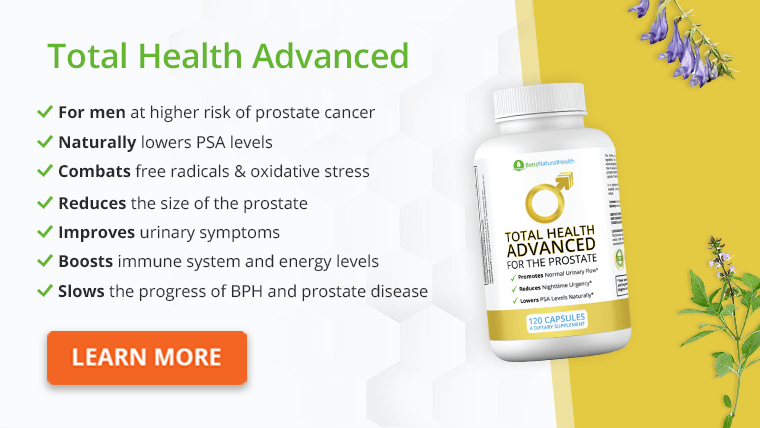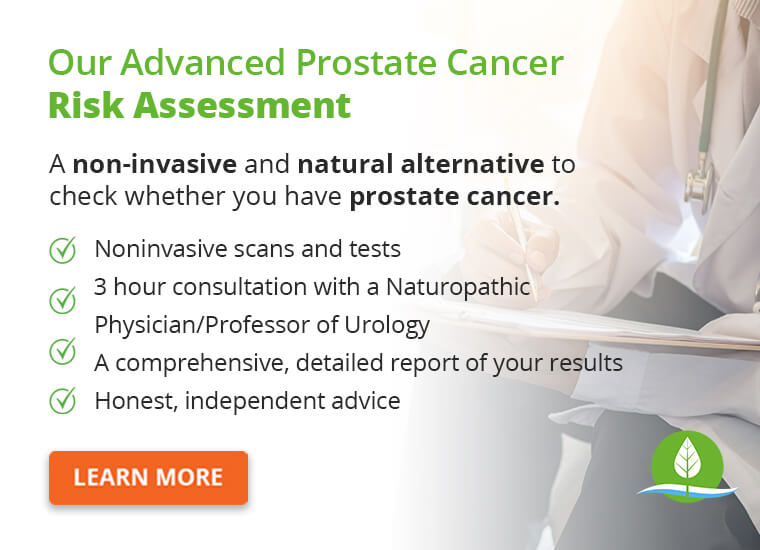- Prostate Screening Is An Effective Detection Strategy
- What is Prostate Cancer Awareness Month?
- The Purpose of Prostate Cancer Awareness Month
- Practical Ways to Get Involved in Prostate Cancer Awareness Month
- The Sheer Impact of Prostate Health Screenings
- Crucial Factors for Pinpointing the Illness
- Risk Factors to Be Familiar With
- How to Minimize the Risk of Prostate Cancer
- Conclusion
- Next Up
- Source
September is prostate cancer awareness month! More than 3 million American men are living with prostate cancer.
Roughly 12.5% of men will be diagnosed with this particular disease at some point in their life. But, the cancer rates are changing.
New prostate cancer cases have been declining by 3.1% a year from 2009 to 2018. Given the 5-year relative survival rate of 97.5%, timely diagnosis remains essential for effective prostate health.
Early diagnosis may offer potential benefits, such as improved care experience, enhanced quality of life, and potentially reduced treatment side effects.
That’s where increasing cancer awareness comes in handy. Health advocates and experts have designated a month to raise awareness about prostate health and related issues.
This includes the importance of prostate cancer screening and prostate education. As well as the need for additional research on prostate complications.
This September, the National Prostate Cancer Awareness Month is preparing for exactly that. Here is what this international campaign is all about.

Prostate Screening Is An Effective Detection Strategy
Health screening can be an effective way to detect conditions in their early stages, sometimes even before symptoms appear.
Spotting the illness early on means obtaining adequate treatment at the right time. This gives people better control of their overall health.
Prostate cancer isn’t the only illness that can benefit from early detection. It can also help people with other types of cancer.
Take ovarian cancer, for example. Up to 90% of those affected can be cured if the illness is detected early on and doesn’t spread outside the ovaries.
Then, there is breast cancer. If found early, patients can obtain a wide range of treatments with a higher survival rate. Women who spot cancer in its early stage have a 93% or higher survival rate in the first five years.
The same thing can happen with pancreatic cancer and lung cancer. The sooner the cancer is diagnosed, the lower the risk of cancer death. Those affected can stop the tumor from spreading or tripling in size, amplifying their survival odds.
What is Prostate Cancer Awareness Month?
- Month: September
- Featuring: Events, funding, sponsorships, distribution of informational material, and more
Although many risk factors are associated with prostate carcinoma, like age, diet, family history, etc, the condition has a relatively high survival rate.
Spotting it early on gives older men a better fighting chance. That’s why Prostate Cancer Awareness Month is here to help.
Prostate Cancer Awareness Month is an international campaign organized annually. Aimed at raising funds for additional research on prostate cancer, promoting cancer awareness and education, it has attracted a wide audience eager to participate.
People concerned with prostate cancer deaths take part in Prostate Cancer Awareness Month. They talk about the viable treatments for prostate carcinoma, like radiation therapy, immunotherapy, or hormone therapy. How do they prevent or stop cancer cells from growing and dividing?
The Purpose of Prostate Cancer Awareness Month
The goal of the prostate cancer awareness program is to provide information and raise awareness to empower individuals to make informed decisions about their health. By obtaining valuable insight, individuals can recognize cancer signs. They can also understand its impact, treatment risk, and comprehend the value of early cancer detection. This, therefore, allows them to take good care of their health and lessen their prostate cancer risk.
Experts recommend doing a PSA test sooner, from 45 years. Especially for men with a family history of prostate carcinoma or African American men. However, only those at a higher risk are advised to take this approach. For everyone else, routine screenings can start at the age of 55. Even for men in good health.
Practical Ways to Get Involved in Prostate Cancer Awareness Month
Do you want to make a change? With better support and prostate cancer awareness, more lives could be saved. But, to provide the necessary treatment and reduce the risk of complications, advances in cancer research are necessary.
These advances don’t happen overnight. Funding is a key component to create that valuable support. It requires an aware and engaged community eager to make connections and motivate people to provide donations.
You can do that by:
- Volunteering
- Organizing DIY fundraisers
- Sharing your story
- Participating in events, public forums, and various outings
- Joining the AACR (American Association for Cancer Research) runners to raise funds for cancer research
- Partnering up with customers, clients, employees, and the community. All to support prostate cancer research
- Placing donations in the hands of experts working on prostate cancer breakthroughs
As a health care provider, you can also make a valuable addition to this prostate cancer program. You can inspire those affected to make informed decisions about their health, even if you are not active participants.
Communicate with patients about the nature and risk of prostate cancer. Share your knowledge with them so that they can recognize the benefits and need for learning. Inform them about Medicare and insurance policies, so they have everything they need to get the necessary treatment.
The Sheer Impact of Prostate Health Screenings
Only a fraction of men (0.1%) younger than 50 develops prostate cancer. Most cancer cases (85%) happen in men older than 65, with a median age of 71.
With the development of prostate-specific antigen (PSA) screenings, people could detect illness early. This is done via a blood test. Although it’s not foolproof, it can ensure some level of reassurance, particularly for individuals who don’t have cancer.
Besides, since PSA was invented, the number of deaths from prostate carcinoma drastically decreased. This makes it a crucial component in men’s health and the need to boost prostate cancer awareness.
Types of Prostate Screenings
Other than PSA, men can use a digital rectal exam. The doctor will use a lubricated, gloved finger and insert it into the rectum. The urology expert will then assess the state of the prostate and look for any abnormalities in the prostate gland.
Doing a urine test is another extremely accurate option for spotting aggressive prostate carcinoma. It does come with a few false negatives. But it can detect the PCA3 gene in the urine. This is crucial for assessing the possibility of developing prostate cancer.
Doctors can suggest an MRI to look for signs of a metastasized cancer. These images can assist with treatment planning, like radiation or surgery.

Crucial Factors for Pinpointing the Illness
Prostate carcinoma is not always easy to spot. Sometimes men are asymptomatic. That’s until the carcinoma has become bigger and added pressure to the urethra. Other people, on the other hand, develop typical symptoms, which are relatively easy to recognize.
These include:
- Weak flow when urinating
- Taking a very long time to pee
- Having trouble emptying the bladder completely
- Frequent need to urinate, which keeps you awake at night
- Regularly rushing to the toilet
Having these signs doesn’t necessarily mean that you have prostate cancer. They could be the result of another health condition that’s not cancerous, like prostate enlargement. If you have any doubts, consult with a specialist. They can let you know what kind of illness you are dealing with.
Risk Factors to Be Familiar With
- Age is a major factor when it comes to prostate cases. 66 is the average age of prostate cancer diagnosis. Rarely is anyone affected under 40.
- Having someone in the family with this illness can make you susceptible to it.
- Race is another predominant factor, with people of African and African-Caribbean descent having the highest odds of developing the illness.
- Not paying attention to the food you eat can have profound consequences on your prostate. When consuming too much animal fat, you can affect the state of your prostate. So, eating healthy should be a top priority.
- Defoliants and chemicals are additional contributors. Working with a huge amount of pesticides exposes individuals to cadmium, making them vulnerable to this illness.
How to Minimize the Risk of Prostate Cancer
As the second leading cause of death in the U.S., cancer has had a major impact on many families. But, some cases could be avoided or caught early. Tackling obesity, dangerous drinking, or smoking habits is a practical method of lowering your chances. Also, getting excessive amounts of UV rays, mainly from tanning beds, can make you prone to the condition. So, you should watch out for how much time you spend on sunbeds.
Maintaining a healthy body weight also play an important role, with numerous studies have shown that men with high body mass index (BMI) have an increased risk of prostate cancer. Consider maintaining a balanced diet that includes essential nutrients, vitamins, and minerals, and limiting excessive fat intake.
Maintaining a healthy and active lifestyle contributes to overall well-being and may have various health benefits. Although it doesn’t guarantee complete preventive success, it does offer a plethora of benefits. Your body will have all the nutrients it needs to function properly. Therefore, ensuring a good quality of life.
Get Your FREE PSA Lowering Diet Plan!
- Naturally lower PSA levels
- Reduce nighttime trips to the bathroom
- Enjoy better bladder control and urine flow
Conclusion
Prostate cancer can drastically affect someone’s life. But, with early treatment, it becomes much easier to manage.
That’s why programs like Prostate Cancer Awareness Month are here to stay. By providing everyone with accessible information, education, and awareness, they can better manage their condition and avoid serious complications.
If you too want to advocate for more research, then take part in this annual program. Here, you can concentrate on what really matters – making the public better informed on their prostate. With bigger numbers, we can all make a more notable impact.
Next Up








